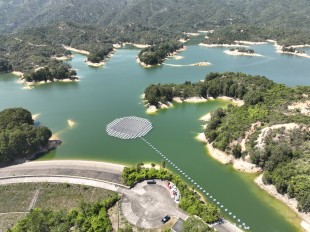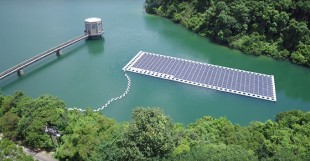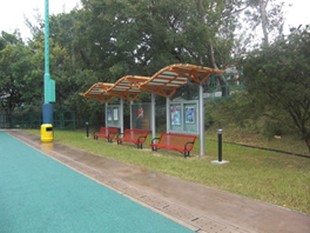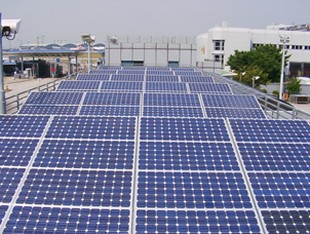
In accordance with the Hong Kong’s Climate Action Plan 2050 promulgated in October 2021, the Government is grappling with Hong Kong’s geographical and environmental constraints in driving the development of Renewable Energy (RE), and strive to increase its share in the fuel mix for electricity generation to 7.5% to 10% by 2035, and further increase it to 15% subsequently through facilitating local RE projects, regional cooperation and joint ventures, etc.
In recent years, the Government has applied innovative technology to develop RE projects in various suitable premises.
Regarding solar energy, the Water Supplies Department (WSD) has installed floating solar energy generation systems of 100 kilowatts (kW) each at Shek Pik Reservoir, Plover Cove Reservoir and Tai Lam Chung Reservoir to explore the potential of installing floating solar energy generation systems at reservoirs for electricity generation; whereas the Drainage Services Department (DSD) has installed in phases high-efficiency thin-film solar energy generation systems on the curved sedimentation tank covers at Stonecutters Island Sewage Treatment Works which occupy an area of about 30 000 m² to supply electricity for the plant. Besides, the Environmental Protection Department (EPD) commissioned a 150 kW solar energy generation system at Jordan Valley Landfill in February 2023, which is the first solar energy generation system on a restored landfill in Hong Kong with a view to making better use of vacant land and promoting the sustainability of restored landfills.
Floating solar energy generation system at Tai Lam Chung Reservoir
Thin-film solar energy generation system at Stonecutters Island Sewage Treatment Works
As regards waste-to-energy, the Food Waste/Sewage Sludge Anaerobic Co-digestion Trial Scheme, jointly launched by the DSD and the EPD at Tai Po and Sha Tin Sewage Treatment Works receives food waste for food waste/sewage sludge anaerobic co-digestion. Under this trial scheme, each Sewage Treatment Works could treat up to 50 tonnes of food waste per day and generate about 950 000 kilowatt-hours (kWh) of energy annually. The Government has also put into operation Organic Resources Recovery Centre Phase 1 (O·PARK1), Organic Resources Recovery Centre Phase 2 (O·PARK2) and Sludge Treatment Facility (T·PARK) to generate surplus electricity from organic waste and sewage sludge for export to the grid respectively, which will serve as good reference for the Government’s planning of other waste-to-energy facilities in future.
Food waste and sewage sludge anaerobic co-digestion facility at Tai Po Sewage Treatment Works
T · PARK in Tuen Mun was fully commissioned in April 2016 and is the first large-scale waste-to-energy facility in Hong Kong. The heat energy generated from the sludge incineration process is recovered and turned into electricity that can support the needs of the entire facility. When running at full capacity, it can produce up to 2 megawatts (MW) of surplus electricity for the public power grid, which is an impeccable example of waste-to-energy in action.
O·PARK1 in North Lantau was commissioned in 2018, with a treatment capacity of 200 tonnes of food waste per day. O·PARK1 transforms organic waste into biogas and compost. Biogas is utilised to generate electricity and about 14 million kWh of surplus electricity can be exported to the public power grid when running in full capacity, which is equivalent to the electricity consumption of about 3 000 households. O·PARK2 in North District was also commissioned in 2024, with a treatment capacity of 300 tonnes of food waste per day. O·PARK2 adopts advanced technologies to convert food waste into biogas and fertilizer. In addition to providing electricity and heat for its own facilities, the surplus biogas is used for production of electricity. About 24 million kWh surplus electricity can be generated annually when running in full capacity, which is equivalent to the electricity consumption of about 5 000 households.
In addition, the Government has also earmarked HK$3 billion in total since the 2017-18 financial year for the installation of small-scale RE facilities at government buildings, venues and facilities with about 226 projects under implementation, which can generate about 25 million kWh of electricity per annum.

Floating solar energy generation systems on Shek Pik Reservoir

Solar powered lamps at Sai Kung Outdoor Recreational Centre

Solar energy generation systems at Airport Police Station
If you want to find out more about existing Government RE projects, please visit the Electrical and Mechanical Services Department (EMSD)’s HK RE Net.
The Government will continue lead by example in optimising the favourable conditions of premises and developing RE, including raising the requirements of applying RE technologies in new government buildings, and developing large-scale solar energy generation and waste-to-energy projects at suitable venues. For instance, the DSD is exploring the feasibility of installing floating or other appropriate types of solar energy generation systems in suitable water bodies through pilots at places like San Tin Polder. In addition, through multi-disciplinary and inter-departmental collaboration, the Government will launch the Pilot Scheme on Building-Integrated Photovoltaics at the EMSD Headquarters to explore photovoltaic technology applications on the facades of buildings as well as the supply of RE to buildings.
Floating solar energy generation system at San Tin Polder
The EPD is also actively exploring the installation of larger scale solar energy generation systems at restored landfills, including the launch of a 1 MW pilot solar farm project at the SENT Landfill in Tseung Kwan O.
In parallel, the Government is taking forward other waste-to-energy facilities. I·PARK1 is under construction on an artificial island off Shek Kwu Chau, with an aim of commissioning the facility in 2025. The facility will use advanced moving grate incineration technology to treat up to 3 000 tonnes of municipal solid waste per day. Once I·PARK1 is in full operation, energy recovered from the waste will generate surplus electricity of 480 million kWh annually, which is equivalent to the electricity consumption of about 100 000 households.
As part of the Government’s on-going efforts to promote RE, the EMSD publishes on its HK RE Net some useful information on RE, including the application of different RE technologies in Hong Kong and overseas, existing RE projects being operated by the Government and the private sector, as well as the relevant statistical information. For details, please visit HK RE Net.